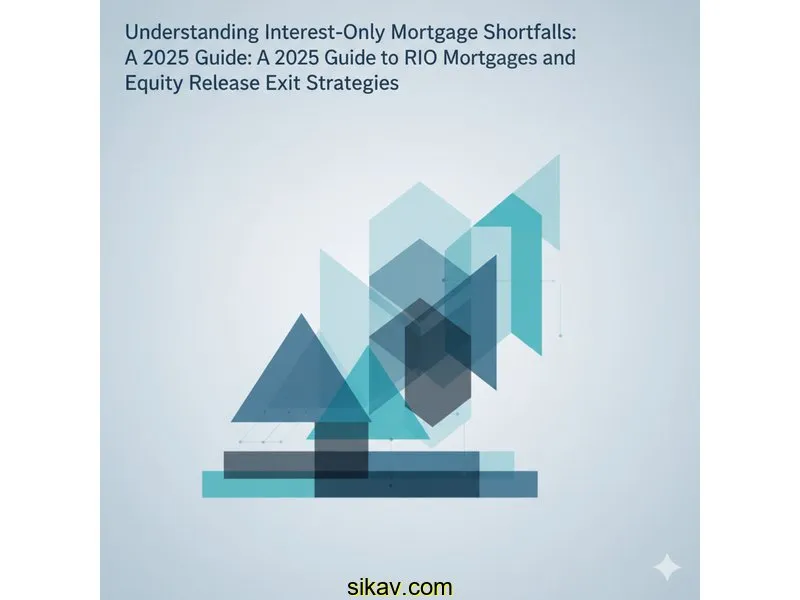
Picture this: You’re approaching the end of a 25-year interest-only mortgage term. You’ve faithfully paid the monthly interest, but the huge capital amount—the original loan—is suddenly due, and your chosen repayment vehicle (perhaps an endowment policy or a pension lump sum) has fallen short. You’re staring at a **shortfall** of £50,000 or even £100,000, and the pressure is mounting. If this scenario sounds familiar, you’re not alone. The interest-only mortgage "time bomb" has been a significant concern for UK homeowners who took out these deals in the 1990s and early 2000s.
Getting a handle on an interest-only shortfall isn't just about finding the cash—it's about navigating a complex landscape of regulations and products designed for later life. While a typical repayment mortgage is structured to clear the debt automatically, an interest-only loan places the entire burden of repayment strategy squarely on the borrower. This article, written from my perspective as a developer and financial researcher, explores the three main strategies you can take to close that gap, focusing specifically on the nuanced criteria of **Retirement Interest-Only (RIO) mortgages** and **Equity Release** as practical exit strategies for those in or approaching retirement.
Key Takeaways
- Shortfall Risk: An estimated **1.4 million interest-only mortgages** are still outstanding in the UK, many of which are predicted to face a repayment shortfall (Financial Conduct Authority, 2024).
- RIO Criteria: A **Retirement Interest-Only (RIO) mortgage** is a regulated solution, but requires strict proof of affordability for the interest payments, with repayment triggered only by death or moving into long-term care.
- Equity Release Alternative: For those who cannot meet RIO affordability criteria, **Lifetime Mortgages (Equity Release)** may be an option, allowing interest to roll up, but it will significantly reduce the inheritance value of your home.
- When to Act: You might not get a new interest-only deal if your remaining mortgage term is less than five years—**start planning your exit strategy at least 5 to 7 years before the term ends.**
- Disclaimer: This article provides informational guidance based on current UK lending and regulatory frameworks as of November 2025. It is not financial or legal advice. Products like RIO mortgages and Equity Release are complex and require specialist consultation with a qualified mortgage or equity release advisor.
The Shortfall Dilemma: Why the Capital is Still Due
The core issue with an interest-only mortgage is that it is a **contract to repay the interest, not the capital**. Think of the mortgage as two separate parts: the interest repayments (your monthly bill) and the capital repayment vehicle (the lump sum you were supposed to be saving separately). When interest rates were lower and endowment policies were common, many people relied on these linked investments to mature and cover the debt.
Here’s the thing: many endowment policies performed poorly, and life events may have interrupted dedicated saving plans. When the mortgage term ends, the bank requires the initial capital back. They don't care if your chosen strategy worked; they simply want the principal. This is why a shortfall can be such a shock—the final payment is not another month’s interest, but the original £150,000, £200,000, or more, all at once.
This challenge has led to significant regulatory scrutiny. A recent report by the FCA highlighted that the number of interest-only mortgages maturing in the UK peaks between 2026 and 2028, underscoring the urgency for thousands of homeowners to find a credible exit strategy (Financial Conduct Authority, 2024). Let's explore the primary options available to address that capital debt.
Scenario-Based Breakdown: Closing the Shortfall Gap
To make sense of the options, let's look at the three main ways you can tackle an approaching interest-only mortgage shortfall. The table below compares your short-term options (Remortgage/Conversion) with longer-term retirement solutions (RIO and Equity Release), which are often the most viable choices for older borrowers.
| Customer Scenario | Financial Goal | Key Requirement | Product Type | What You Must Do |
|---|---|---|---|---|
| **Scenario 1: Shortfall is small/Mid-career** | Clear the debt completely over a new term (e.g., 5-10 years). | High income proof & under 55 years old. | Repayment Mortgage (Remortgage) | Convert to a standard Repayment mortgage, increasing monthly payments dramatically to cover interest + capital. |
| **Scenario 2: Approaching Retirement & Good Income** | Lower monthly costs; defer capital repayment until death/care. | Must be 55+ and prove you can afford the monthly **interest** payments post-retirement. | Retirement Interest-Only (RIO) Mortgage | Apply for a RIO. Prove that your retirement income (pensions, investments) is sufficient to cover the interest for life. |
| **Scenario 3: Retirement & Limited Income/Shortfall** | Clear the debt entirely without any monthly payments. | Must be 55+ (or 65+) and accept interest roll-up. No income proof required. | Lifetime Mortgage (Equity Release) | Use the tax-free lump sum to clear the old interest-only debt. Interest on the new loan rolls up and is repaid from the sale of the house. |
As you can see, the choice hinges primarily on your age and, crucially, your post-retirement **income**. If your income is stable and verifiable, a RIO mortgage is a highly regulated, sensible option. If your income is a concern or you prefer to eliminate all monthly payments, Equity Release is the tool that offers a solution, albeit one that impacts the final value of the estate.
Deep Dive: The Retirement Interest-Only (RIO) Solution
A RIO mortgage is effectively a standard interest-only mortgage that has been specifically adapted and regulated for older borrowers (55+). It operates under a much more stringent affordability assessment than older interest-only loans. Lenders are required to be absolutely sure that you can afford the interest for the rest of your life. The product is regulated by the FCA as a standard mortgage, meaning you benefit from the stringent affordability checks that were often missing from the original interest-only deals.
So you’ve identified that your shortfall needs a long-term interest-only solution. Now what? The RIO route requires detailed proof of income.
Let's explore the practical implementation. The RIO mortgage is designed to be repaid only when a 'life event' occurs—typically the death of the last borrower or when the last borrower moves into long-term care. This provides homeowners with certainty that they won't be forced to sell to repay the capital amount at a specific date. However, **affordability is the gatekeeper**. According to a 2025 market analysis, RIO lenders typically require borrowers to demonstrate a retirement income sufficient to cover interest payments even after potential partner income is removed, ensuring the surviving person can still afford the home (UK Mortgage Advice Bureau, 2025).
Step-by-Step: RIO Affordability and Application
1. Project Future Income: You must accurately project your **adjusted net income** post-retirement, including state pension, private pensions, and verifiable investment income. Lenders use rigorous stress tests, often looking at an interest rate significantly higher than the current rate.
2. Address the Surviving Borrower: If applying with a partner, the lender must be satisfied that the single, surviving borrower can afford the interest payments alone. This is often the biggest hurdle to clear.
3. Complete Regulation Requirements: Because RIO mortgages are regulated, you must receive advice from a qualified RIO mortgage broker. They will guide you through the process, ensuring you understand the long-term commitment and the exit strategy.
Edge Cases / Advanced Topics: When RIO Isn't Enough
What if your retirement income is low, or you need to access some of the property's equity to improve your lifestyle? This is where a Lifetime Mortgage (Equity Release) comes in. While RIO still demands the monthly interest payment, a Lifetime Mortgage allows the interest to **roll up** and compound over time, being repaid only when the house is eventually sold. This eliminates the monthly payment but significantly erodes the equity.
A crucial distinction: Equity release is regulated by the FCA, and providers belonging to the Equity Release Council offer guarantees such as a **'No Negative Equity Guarantee'** (Equity Release Council, 2025). This assurance means that you will never owe more than the sale price of your home. For a large number of homeowners facing a shortfall, where affordability for a RIO is borderline, the ability to eliminate monthly payments and access a tax-free lump sum to clear the old loan is a powerful incentive.
Common Questions About Interest-Only Shortfalls

Based on questions I've seen across UK homeowner forums and Reddit's r/UKPersonalFinance, here are the three most common points of confusion when a final repayment date looms.
Can I force the lender to extend my interest-only term?
The short answer is no. The mortgage is a legal contract with a fixed end date. Your lender has the right to demand repayment of the capital when the term expires. While most lenders will attempt to help you find a regulated, affordable solution (like a RIO or repayment conversion), they are not obligated to simply extend the term unless you can prove a credible and affordable exit strategy. It is vital to communicate with your lender early—don't wait until the last 12 months to open the conversation.
What happens if I simply can't pay the shortfall?
If you cannot repay the capital at the end of the term and no new product (RIO, Lifetime Mortgage, or Remortgage) is affordable or suitable, the lender will follow their standard forbearance and repossession procedures. They will usually work with you for a period to allow for the orderly sale of the property, as this is typically the cleanest way to clear the debt. However, the ultimate outcome is that the property may need to be sold to clear the outstanding loan, and any remaining equity (after the loan and costs are paid) is returned to you.
Is a Retirement Interest-Only (RIO) mortgage really a lifetime solution?
Yes, it is designed to be a lifetime solution for the borrowers. Unlike older interest-only mortgages that had a maximum age limit (e.g., 75 or 80), RIO mortgages have no maximum age limit for the end of the term. The loan is designed to run until the borrower passes away or moves into care. This means that if you are 65 and take a RIO, the loan will remain in place for as long as you live, provided you continue to meet the monthly interest payments.
Conclusion: Your Next Steps
Understanding the interest-only shortfall comes down to three core principles: **Early Intervention**, **Affordability Analysis**, and **Product Choice**. If your mortgage is due to mature in the next five years, start acting now. Determine your likely retirement income and use that to assess if you can meet the stringent affordability checks for a RIO mortgage, which provides a regulated, long-term solution by converting the mortgage into a lifetime commitment. If RIO is not viable due to income constraints, then Equity Release (a Lifetime Mortgage) becomes the primary alternative to eliminate the monthly debt, though it will reduce the value of your estate.
The key takeaway is that you have options, but they require specialist advice. Products like RIO and Lifetime Mortgages are in the regulated space, meaning you cannot apply without speaking to a qualified advisor. This guide provides a framework for understanding the mechanisms and the critical differences between the two main later-life options. For your specific financial situation and for a personalised illustration of costs and eligibility, always consult a qualified mortgage or equity release advisor who can navigate the small print and the rapidly changing criteria of the specialist lending market.

